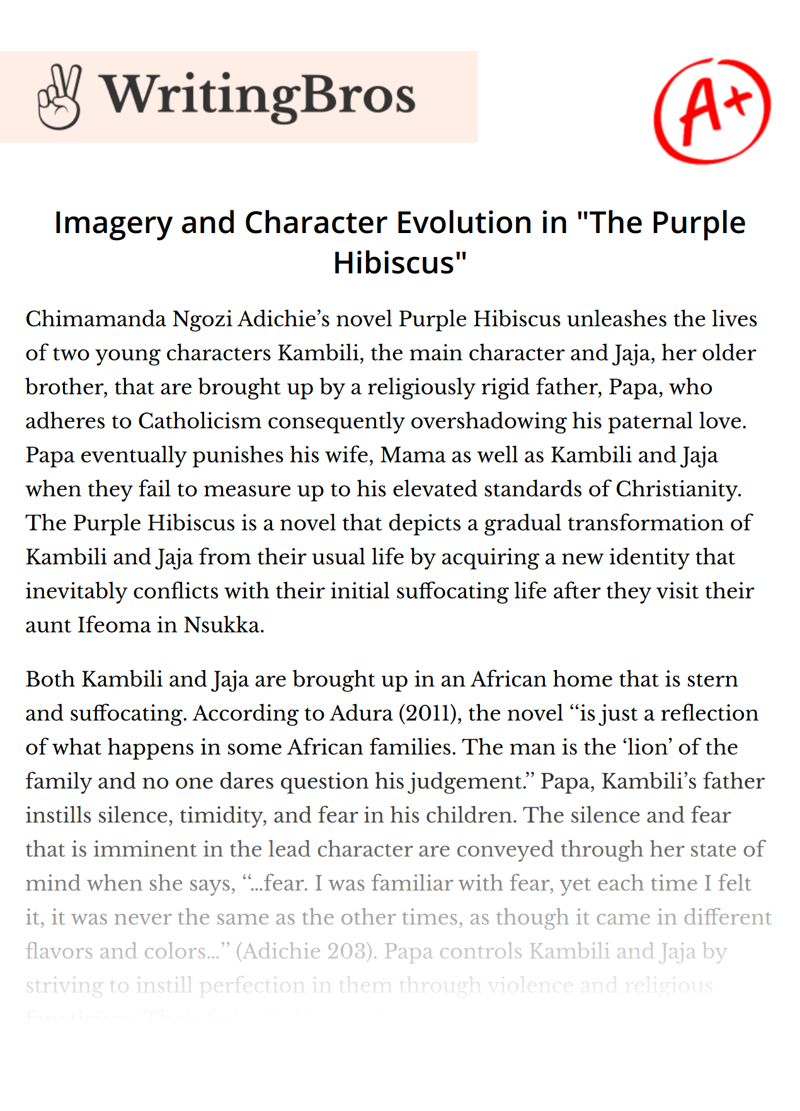Imagery and Character Evolution in "The Purple Hibiscus"

Chimamanda Ngozi Adichie’s novel Purple Hibiscus unleashes the lives of two young characters Kambili, the main character and Jaja, her older brother, that are brought up by a religiously rigid father, Papa, who adheres to Catholicism consequently overshadowing his paternal love. Papa eventually punishes his wife, Mama as well as Kambili and Jaja when they fail to measure up to his elevated standards of Christianity. The Purple Hibiscus is a novel that depicts a gradual transformation of Kambili and Jaja from their usual life by acquiring a new identity that inevitably conflicts with their initial suffocating life after they visit their aunt Ifeoma in Nsukka.
Both Kambili and Jaja are brought up in an African home that is stern and suffocating. According to Adura (2011), the novel ‘‘is just a reflection of what happens in some African families. The man is the ‘lion’ of the family and no one dares question his judgement.’’ Papa, Kambili’s father instills silence, timidity, and fear in his children. The silence and fear that is imminent in the lead character are conveyed through her state of mind when she says, ‘‘…fear. I was familiar with fear, yet each time I felt it, it was never the same as the other times, as though it came in different flavors and colors…’’ (Adichie 203). Papa controls Kambili and Jaja by striving to instill perfection in them through violence and religious fanaticism. Their father’s dictatorship saddens them since they lack adventure hence they lack their own identity by being robotic and mute. Their house is enclosed by red hibiscuses that symbolize danger and walls that cage Kambili and Jaja’s minds. Adichie (2006), echoes this kind of sadness when she narrates ‘‘I wanted to smile, but we were driving past our house just then, and the sight of the looming gates and white walls stiffened my lips.’’
Kambili and Jaja’s visit to aunt Ifeoma in Nsukka gradually transforms them positively while their initial silent lives are impacted negatively. The journey motif is evident in the novel which depicts the characters’ adventure that results in self-realization or an epiphany. Adichie stylistically employs a journey motif to initiate the children’s transformation process. The new environment in the journey process catalyzes their development and self-realization resulting in the characters’ gradual transition. Besides, aunt Ifeoma parents her children differently and her home is filled with happiness and purple hibiscuses that symbolize freedom and beauty. The journey motif sheds the children’s old ideologies and sparks the evolution of new ones. Kambili internalizes new ideas where she observes that ‘‘mostly, my cousins did the talking and aunt Ifeoma sat back and watched them’’ (Adichie 128). Consequently, Kambili and her brother, Jaja, in the new setting become vocal and adventurous in sports and gardening respectively. This is unlike their old setting, in their suffocating father’s house. Additionally, Father Amadi equally encourages Kambili to do and be whoever she wants. More visits to aunt Ifeoma reconstruct and redefines them emotionally and psychologically in that they plant aunt Ifeoma’s purple hibiscuses in their home. Jaja develops guts and refuses taking communion and insists on going back to Ifeoma’s residence while Kambili clings onto her grandfather’s picture despite being beaten by her father because of the portrait. Eventually, Kambili and Jaja’s transformation deteriorates Papa’s suffocating system. Their father is shocked by who Jaja has become in his house. Kambili observes that ‘‘there was a shadow clouding Papa’s eyes, a shadow that had been in Jaja’s eyes. Fear. It had left Jaja’s eyes and entered Papa’s’’ (Adichie 21). Therefore, in the novel Purple Hibiscus, Kambili and Jaja undergo gradual character transformation after they visit their aunt Ifeoma in Nsukka.
Conclusion
To conclude, Adichie’s novel Purple Hibiscus depicts a gradual character evolution. Kambili and Jaja are living in a quiet and dictatorial life that is presided over by their overly religious father. Contrastingly, after their visit to their aunt’s place in Nsukka, the new environment in aunt Ifeoma’s abode gradually ignites their development and self-realization. Eventually, they object to their father’s misleading and violent ways by ignoring his dictating rule. Consequently, the children gradually evolve to a new life by embracing development and self-realization after they visit their aunt Ifeoma in Nsukka.
Cite this Essay
To export a reference to this article please select a referencing style below

